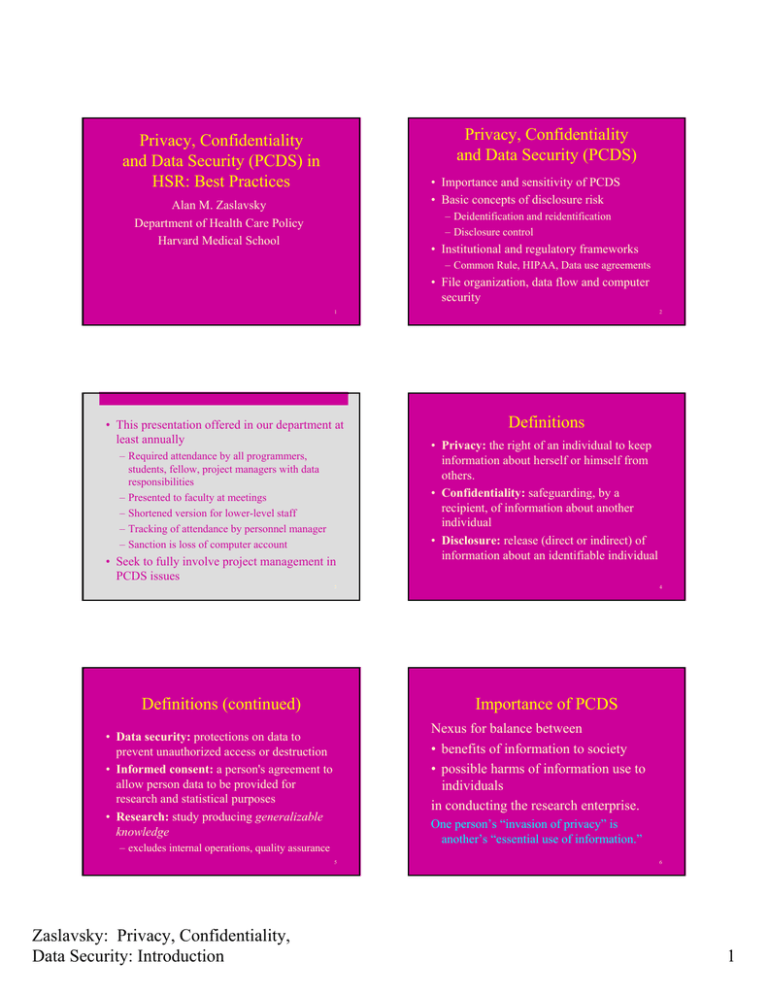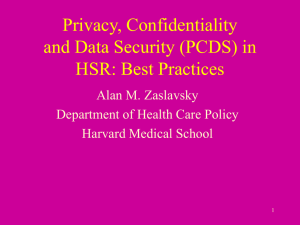Privacy, Confidentiality and Data Security (PCDS) and Data Security (PCDS) in
advertisement

Privacy, Confidentiality and Data Security (PCDS) Privacy, Confidentiality and Data Security (PCDS) in HSR: Best Practices • Importance and sensitivity of PCDS • Basic concepts of disclosure risk Alan M. Zaslavsky Department of Health Care Policy Harvard Medical School – Deidentification and reidentification – Disclosure control • Institutional and regulatory frameworks – Common Rule, HIPAA, Data use agreements • File organization, data flow and computer security 1 • This presentation offered in our department at least annually – Required attendance by all programmers, students, fellow, project managers with data responsibilities – Presented to faculty at meetings – Shortened version for lower-level staff – Tracking of attendance by personnel manager – Sanction is loss of computer account • Seek to fully involve project management in PCDS issues 2 Definitions • Privacy: the right of an individual to keep information about herself or himself from others. • Confidentiality: safeguarding, by a recipient, of information about another individual • Disclosure: release (direct or indirect) of information about an identifiable individual 3 Definitions (continued) Importance of PCDS Nexus for balance between • benefits of information to society • possible harms of information use to individuals in conducting the research enterprise. • Data security: protections on data to prevent unauthorized access or destruction • Informed consent: a person's agreement to allow person data to be provided for research and statistical purposes • Research: study producing generalizable knowledge One person’s “invasion of privacy” is another’s “essential use of information.” – excludes internal operations, quality assurance 5 Zaslavsky: Privacy, Confidentiality, Data Security: Introduction 4 6 1 Inherent conflicts Costs of violations of PCDS • Law enforcement / legal process • General access to research data • Damage to subjects – Material – Psychological/social – Freedom of Information Act (FOIA) • Commercial use / beneficial products & services? • Prevention of harm • Need to save data for verification, revision • Damage to the research enterprise • Exposure to legal/administrative sanctions for researchers and data providers and their institutions 7 Direct and indirect identifiers 8 Direct Identifiers (keys) Key: variable or combination of variables, the value for which results in a record being unique in the target and population data Direct identifier: Information that is uniquely associated with a person. Indirect identifier: Data which, in combination are uniquely associated with a person. Information which facilitates such associations. •Name . •Telephone number •Street /e-mail address •Unique features (SSN, Medicare ID, Health plan, Medical record #, Certificate/License, voice-finger prints, photos) 9 Data in Combination Re-identification by Matching De-identification Original target file Anonymized target file Variables might be identifying in combination that are not identifying by themselves Name abcdefghijkl abcdefghijkl • Month, day and year of birth • Gender • Zip code Re-identification key Anonymized target file abcdefghijkl Population file abcdefmnop Name 11 Zaslavsky: Privacy, Confidentiality, Data Security: Introduction 10 12 2 Population (External) Data Bases Example of reidentification using three variables Variables list Birthdate alone Birthdate + gender Birthdate + Zip (5) Birthdate + Zip (9) % Unique in Maine state voter registration • Voter Registration Lists • Research files • State & Federal Files – Survey files with added administrative data 12 29 69 97 • Information Vendor Files • The unknown: what might an “intruder” know about some or all members of your population? Sweeney, 1997 13 Identifiable population groups (entire data set highly identifiable) 14 Unique/unusual cases: rare values • 110 year-old woman • Man who weighs 350 pounds • Income > $100 million • Rare diseases •Sample drawn from a particular area • Verbatim text containing identifying details 15 Unique/unusual cases: rare combinations of values Micro Data Protection 1 • 16 year-old widow • 20 year-old Ph.D. • Asian race in rural mid-west • Female/Asian Executive • 60-year old male married to 30 year-old female • Cause of death = prostate cancer for 30 year-old male 17 Zaslavsky: Privacy, Confidentiality, Data Security: Introduction 16 • Remove direct identifiers • Restrict geographical detail • Code to remove detail – larger categories, top/bottom coding • Remove, code or edit verbatim comments • Case suppression • Variable suppression 18 3 Micro Data Protection 2 Tabular data • Special handling (e.g. coding) of data from external sources (esp. area data) • Statistical modification (“noise”) • Sample/subsample • Eliminate link between persons and establishments • Information on individuals deduced from unique cases in tables • Reidentification usually related to small groups, small cell counts • Rounding, cell suppression, complementary suppression might be required 19 Disclosure of individual information from a table Income ($’000) <10 10-25 25-50 >50 Cancer type Colon Lung Kidney 60 80 0 25 36 0 19 12 2 22 14 0 20 Technical issues • Highly technical issues in both microdata and tabular nondisclosure – Intersection of stats, math, computer science Breast 24 36 17 35 • Software for detecting disclosure risk – RTI, μ-argus, etc. • Nontechnical variables – Resources and intentions of “intruder” 21 Disclosure control in released data 22 Restricted access data centers • Affect us as producers and consumers of data • Masking • Alternative to fully-deidentified public-use microdata files • Data are held at restricted center – Affects analyses if performed on data we receive – Complex to implement on our releases – Limited set of researchers submit analyses through intermediaries – Output reviewed for nondisclosure • Only feasible for organizations with substantial, persistent resources • Limited access data centers – e.g. NCHS, Census 23 Zaslavsky: Privacy, Confidentiality, Data Security: Introduction 24 4 Common Rule Institutional and regulatory frameworks for PCDS • • • • • Governs protection of research subjects in all Federally-funded research Common Rule / IRB HIPAA Data Use Agreements State regulations – IRB evaluates adherence by researcher – Institutional sanctions for violations – Many institutions extend to all research • Objective: protection of subject from harm – In HSR, often there is no intervention – Typically, commitment to minimal risk of disclosure 25 Common Rule (continued) 26 Implications for researchers • Informed consent – generally required in primary data-collection – appropriate information about use of data – might be waived where impractical to obtain (e.g. intrusive), if risks minimal & rights not injured • Exemption from (full) review – No intervention that could harm subject – Secondary data with no identifiable data – Requires determination by IRB (but less tedious) • Commitments are made – To subjects: consent language – To IRB: safeguards promised in IRB application – To funding agencies: in grant application • May involve – Protection of data while used – Limits on duration of use 27 HIPAA 28 Who is Covered by HIPAA? Health Insurance Portability and Accountability Act • Specific rules for electronic transmission of health data • A health care provider who transmits health information in electronic transactions – Primarily for efficiency but includes Privacy Rule • Obligations imposed on health care providers – Includes direct providers, health plans and insurers – Research data distinguished from health plan / provider operational functions Example: a physician or hospital who electronically bills for services • A health plan • A health care clearinghouse • Researchers must respect these obligations 29 Zaslavsky: Privacy, Confidentiality, Data Security: Introduction 30 5 HIPAA implications for research • Practical implications of HIPAA Option 1: De-identified Health Information • Completely de-identified information (18 elements removed) and no knowledge that remaining information can identify the individual. OR • Statistically “de-identified” information where a qualified statistician determines that there is a “very small risk ” that the information could be used to identify the individual and documents the methods and analysis. – What data providers will be looking for – Need to work around restrictions on content – More elaborate paths for data control • HIPAA provisions for releasing data for research – fully deidentified – limited use dataset – waiver 31 Removal of These Identifiers Makes Information De-identified – Names – Geographic info (including city and ZIP) – Elements of dates (except year) – Telephone #s – Fax #s – E-mail address – Social Security # – Medical record, prescription #s – Health plan beneficiary #s – Account #s – – – – – – – – Certificate/license #s VIN and Serial #s, license plate #s Device identifiers, serial #s Web URLs IP address #s Biometric identifiers (finger prints) Full face, comparable photo images Unique identifying #s 32 Option 2: Limited Data Set with Data Use Agreement • The Privacy Rule permits limited types of identifiers to be released for research with health information (referred to as a Limited Data Set). • Limited Data Sets can only be used and released in accordance with a Data Use Agreement between the covered entity and the recipient. If the covered entity has actual knowledge that remaining information can be used to identify the individual, the information is considered individually identifiable, and therefore, generally is PHI. 33 Limited Data Set w/ Data Use Agreement • The Limited Data Set CAN contain Option 3: Waiver of Authorization May use or disclose personal inforamtion for research if IRB or Privacy Board determines that : – Elements of Dates – City and ZIP – Other unique identifiers, characteristics and codes not previously listed as direct identifiers (previous slide) – research involves no more than minimal risk – research does not adversely affect the “ rights and welfare” of subjects – the research could not be done without a waiver • CANNOT contain other direct identifiers (among the 18) 35 Zaslavsky: Privacy, Confidentiality, Data Security: Introduction 34 36 6 Data Use Agreements (DUA) State regulations • Between data provider and data user • Restrictions: • Variable from state to state • Some are relatively restrictive – access by specific personnel – use for a specific reason – defined duration of retention – requires negotiation with data provider • Implements commitments made by data provider 37 Iron-clad protection? 38 Data security in complex projects • Certificate of Confidentiality • Multisite projects: special needs • Careful mapping of data flow and access • Minimal identifying information at each stage • Particular care in technical aspects of security – Issued by DHHS – Protects data against legal process – Typically for sensitive topics, e.g. illicit drugs • O, Canada! 39 40 Example of a data flow plan (with security provisions) File management for PCDS • General practices of good management – Practices necessary to maintain project continuity • Well-structured directory organization and naming • Include documentation with files • Separate project data from personal directories • Separate datasets from programs • Separate raw data from analytic datasets 41 Zaslavsky: Privacy, Confidentiality, Data Security: Introduction 42 7 Backups • We typically follow this presentation with a 15-minute tutorial on good practices for data and file management • Conflict of privacy/confidentiality (restrict) and data security (maintain) • Basic backup schedule (undeletable) – All Unix files: 4 month retention – PC files: 2 month retention • Project-specific backup: by request – Only possible if material is properly organized – Permanent media, physical security 43 • The backup policy described here was adopted after several months of faculty discussion 44 General computer security – Computer system managers wanted longer retention – Faculty concerned about unexpected discovery of material intended to be deleted – Conflicts of DUA requirements with rules regarding retention of data for verification, revision of manuscripts, etc. • Proper use of computer accounts, only by authorized individuals • Secure connections for outside access – Remote users – Home or “on road” access via Internet – Applications can be “tunneled” securely • Good practices with passwords • Maintain file permissions to restrict access to authorized users 45 • We follow this up with a training on mechanics of computer security 46 Conclusions – Permissions, file organization, etc. • More or less fine-grained tools for protection of various files • IT staff included in training – Responsible for implementing security and data retention policies for various project datasets • Know your data • Be prepared to accommodate restrictions required by data providers • Maintain general security • Seek guidance for tough situations! • Teach methods for both Unix and Windows sides of our system 47 Zaslavsky: Privacy, Confidentiality, Data Security: Introduction 48 8



